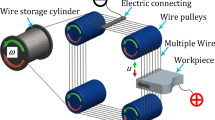Abstract
Micro wire electrochemical machining is a useful technique to produce high-aspect-ratio slit micro-structures. To improve processing stability, the axial electrolyte flow is adopted to renew electrolytes in the machining gap. A wire electrochemical micro-machining system with an axial electrolyte flow unit is developed. A mathematical model of tool feed rate is presented. To investigate the influence of electrolyte flow on processing stability and machining efficiency, comparative experiments were carried out. The influence of applied voltage and electrolyte concentration on machining accuracy is studied and the parameters such as electrolyte flow rate and applied voltage are optimized. Low initial machining gap is applied to decrease the stray current machining in the initial machining period. With the optimal parameters, the high-aspect-ratio micro spline and curved flow channel with the slit width of 160 μm have been fabricated on 5-mm-thick stainless steel (0Cr18Ni9). The width of the slit is uniform and the aspect ratio is 31.
Similar content being viewed by others
References
Bhattacharyya B, Doloi B, Sridhar PS (2001) Electrochemical micro-machining: new possibilities for micro-manufacturing. J Mater Process Technol 113(1–3):301–305
Lee ES, Park JW, Moon YH (2002) A study on electrochemical micromachining for fabrication of microgrooves in an air-lubricated hydrodynamic bearing. Int J Adv Manuf Technol 20(10):720–726
Amalnik MS, McGeough JA (1996) Intelligent concurrent manufacturability evaluation of design for electrochemical machining. J Mater Process Technol 61(1–2):130–139
Schuster R, Kirchner V, Allongue P, Ertl G (2000) Electrochemical micromachining. Science 289(5476):98–101
Munda J, Bhattacharyya B (2008) Investigation into electrochemical micromachining (EMM) through response surface methodology based approach. Int J Adv Manuf Technol 35(7–8):821–832
Ehrfeld W (2003) Electrochemistry and microsystems. Electrochim Acta 48(20–22):2857–2868
Shin HS, Kim BH, Chu CN (2008) Analysis of the side gap resulting from micro electrochemical machining with a tungsten wire and ultrashort voltage pulses. J Micromech Microeng 18(7):1–6
Trimmer AL, Hudson JL, Kock M, Schuster R (2003) Single-step electrochemical machining of complex nanostructures with ultrashort voltage pulses. Appl Phys Lett 82(19):3327–3329
Park JW, Lee ES, Won CH, Moon YH (2003) Development of electrochemical micromachining for air-lubricated hydrodynamic bearings. Microsyst Technol 9(1–2):61–66
Kim BH, Na CW, Lee YS, Choi DK, Chu CN (2005) Micro electrochemical machining of 3D micro structure using dilute sulfuric acid. Ann CIRP 54(1):191–194
Zhu D, Wang K, Qu NS (2007) Micro wire electrochemical machining by using in situ fabricated wire electrode. Ann CIRP 56(1):241–244
Bhattacharyya B, Malapati M, Munda J, Sarkar A (2007) Influence of tool vibration on machining performance in electrochemical micro-machining of copper. Int J Mach Tools Manuf 47(2):335–342
Li Y, Zheng YF, Yang G, Peng LQ (2003) Localized electrochemical micromachining with gap control. Sens Actuators A 108(1–3):144–148
Bhattacharyya B, Munda J (2003) Experimental investigation on the influence of electrochemical machining parameters on machining rate and accuracy in micromachining domain. Int J Mach Tools Manuf 43(13):1301–1310
Wang JY, Xu JW (2001) Principle and application of electrochemical machining. National Defense Industry Press, Beijing, pp 51–52 [in Chinese]
Lee ES, Baek SY, Cho CR (2007) A study of the characteristics for electrochemical micromachining with ultrashort voltage pulses. Int J Adv Manuf Technol 31(7–8):762–769
Jain VK, Kanetkar Y, Lal GK (2005) Stray current attack and stagnation zones in electrochemical drilling. Int J Adv Manuf Technol 26(5):527–536
Author information
Authors and Affiliations
Corresponding author
Rights and permissions
About this article
Cite this article
Wang, S., Zeng, Y., Liu, Y. et al. Micro wire electrochemical machining with an axial electrolyte flow. Int J Adv Manuf Technol 63, 25–32 (2012). https://doi.org/10.1007/s00170-011-3858-5
Received:
Accepted:
Published:
Issue Date:
DOI: https://doi.org/10.1007/s00170-011-3858-5



